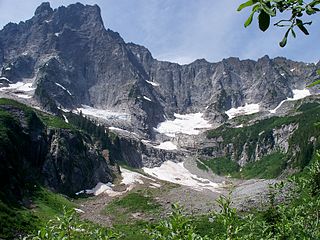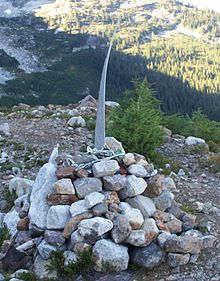
United Air Lines Flight 409 was a scheduled flight which originated in New York City, New York. The final flight destination was San Francisco, California, with stops in Chicago, Denver and Salt Lake City. The aircraft operating the service, a Douglas DC-4 propliner, registration N30062, crashed into Medicine Bow Peak, near Laramie, Wyoming, on October 6, 1955, killing all 66 people on board. The victims included five female members of the Mormon Tabernacle Choir and military personnel. At the time, this was the deadliest airline crash in the history of American commercial aviation. Another 66 lives had been lost earlier that year in the March 22 crash in Hawaii of a United States Navy Douglas R6D-1 Liftmaster military transport aircraft, and 66 had also died in the mid-air collision of two United States Air Force C-119G Flying Boxcars over West Germany on August 11, placing the three crashes in a three-way tie as the deadliest aviation incidents in 1955.

West Caribbean Airways Flight 708 was a charter flight that crashed in northwest Venezuela in the early hours of 16 August 2005, killing all 160 passengers and crew on board. The plane, a McDonnell Douglas MD-82, registration HK-4374X, was en route from Tocumen International Airport (PTY) in Panama City, Panama, to Martinique Aimé Césaire International Airport (FDF) in Fort-de-France, Martinique, France. While flying at 33,000 ft (10,000 m), the aircraft's speed gradually decreased until it entered an aerodynamic stall. The crew, probably under the mistaken belief that the aircraft had suffered a double engine flameout, did not take the necessary actions to recover from the stall. The confusion and lack of action resulted in the crash.
The DeMarco–Becket Memorial Trophy is a Canadian Football League trophy. It is awarded originally to the player selected as the outstanding lineman in the West Division.

Cebu Pacific Flight 387 was a domestic flight from Ninoy Aquino International Airport in Metro Manila to Lumbia Airport in Cagayan de Oro. On February 2, 1998, the 30-year-old McDonnell Douglas DC-9-32 crashed on the slopes of Mount Sumagaya in Claveria. All 104 people on board died in the crash. It is the second deadliest air disaster in the Philippines after Air Philippines Flight 541, which occurred two years later.
The Edmonton Eskimos faced the Montreal Alouettes in the Grey Cup game for the third consecutive year. And for the third consecutive year, the Edmonton Eskimos were Grey Cup champions. It was the first time in a Grey Cup that a touchdown was worth six points instead of five.

Slesse Mountain, usually referred to as Mount Slesse, is a mountain just north of the US-Canada border, in the Cascade Mountains of British Columbia, near the town of Chilliwack. It is notable for its large, steep local relief. For example, its west face drops over 1,950 m (6,398 ft) to Slesse Creek in less than 3 km (2 mi). It is also famous for its huge Northeast Buttress; see the climbing notes below. The name means "fang" in the Halkomelem language. Notable nearby mountains include Mount Rexford and Canadian Border Peak in British Columbia, and American Border Peak, Mount Shuksan, and Mount Baker, all in the US state of Washington.

Calvin Jack Jones was an American professional football guard. Jones played college football for the Iowa Hawkeyes and he is one of only two players to have his jersey number retired by the school. Jones became the first Hawkeye and the first African-American, to win the Outland Trophy in 1955. He played one year with the Winnipeg Blue Bombers of the Western Interprovincial Football Union (WIFU). He died in a plane crash after playing in the East–West All-Star Game.

All Nippon Airways (ANA) Flight 60 was a Boeing 727-81 aircraft making a domestic commercial flight in Japan from Sapporo Chitose Airport to Tokyo Haneda International Airport. On February 4, 1966, all 133 people on board died when the plane mysteriously crashed into Tokyo Bay about 10.4 km from Haneda in clear weather conditions while on a night approach. The accident was the worst involving a single aircraft in Japan and also the deadliest accident in the country until All Nippon Airways Flight 58 crashed five years later, killing 162 people.

The Grand Canyon mid-air collision occurred in the western United States on June 30, 1956, when a United Airlines Douglas DC-7 struck a Trans World Airlines Lockheed L-1049 Super Constellation over Grand Canyon National Park, Arizona. The first plane fell into the canyon while the other slammed into a rock face. All 128 on board both airplanes perished, making it the first commercial airline incident to exceed one hundred fatalities. The airplanes had departed Los Angeles International Airport minutes apart from each other and headed for Chicago and Kansas City, respectively. The collision took place in uncontrolled airspace, where it was the pilots' responsibility to maintain separation. This highlighted the antiquated state of air traffic control, which became the focus of major aviation reforms.

Edwin Charles Harrison is the offensive line coach for the Saskatchewan Roughriders of the Canadian Football League (CFL). He is a former professional gridiron football guard who was a member of the Calgary Stampeders and the Kansas City Chiefs. He won a Grey Cup championship with the Stampeders in 2014. He played college football at Colorado.
Melvin Howard Becket, was an American college football and professional Canadian football player, and was one of 62 people who died on Trans-Canada Air Lines Flight 810, on December 9, 1956.
Mario Joseph DeMarco, was an American college football, National Football League (NFL), and professional Canadian football player, and was one of 62 people who died on Trans-Canada Air Lines Flight 810, on December 9, 1956.
Gordon Henry Sturtridge was a professional Canadian football player, and was one of 62 people who died on Trans-Canada Air Lines Flight 810, on December 9, 1956.
Raymond Nicholas "Ray" Syrnyk, was a professional Canadian football player, and was one of 62 people who died on Trans-Canada Air Lines Flight 810.
In aeronautics, loss of control (LOC) is the unintended departure of an aircraft from controlled flight and is a significant factor in several aviation accidents worldwide. In 2015 it was the leading cause of general aviation accidents. Loss of control may be the result of mechanical failure, external disturbances, aircraft upset conditions, or inappropriate crew actions or responses.

On 9 May 2012, a Sukhoi Superjet 100 airliner on a demonstration tour in Indonesia crashed into Mount Salak, in the province of West Java. All 37 passengers and 8 crew on board were killed. The plane had taken off minutes before from Jakarta's Halim Airport on a promotional flight for the recently launched jet, and was carrying Sukhoi personnel and representatives of various local airlines.

Tara Air Flight 193 was a scheduled domestic passenger flight from Pokhara to Jomsom, Nepal. On 24 February 2016, eight minutes after take-off, the aircraft serving the flight, a Viking Air DHC-6-400 Twin Otter went missing with 23 people on board. Hours later, the wreckage was found near the village of Dana, Myagdi District. There were no survivors. It was Tara Air's deadliest accident.

West Wind Aviation Flight 282 was a domestic passenger flight from Fond-du-Lac Airport to Stony Rapids Airport, Canada. The aircraft was an ATR 42-320 registered C-GWEA. On 13 December 2017, shortly after taking off from Fond-du-Lac, the ATR-42 lost altitude and hit the ground. All 25 passengers and crew initially survived the crash, but one passenger later died of his injuries in hospital. Investigation on the cause of the crash determined that it was caused by ice contamination on the aircraft.














